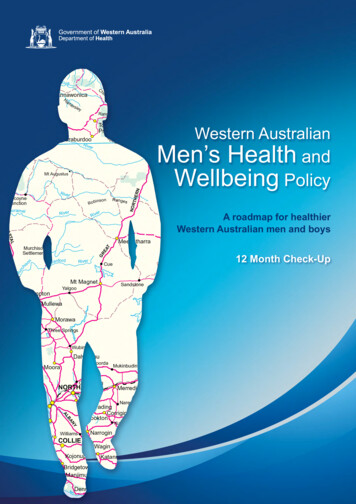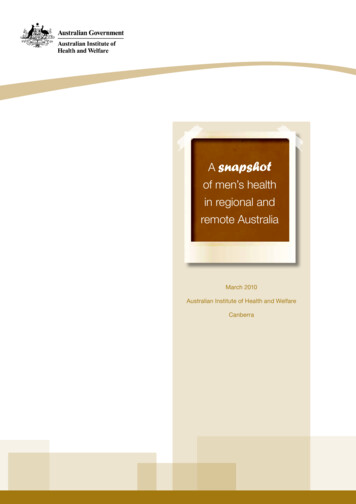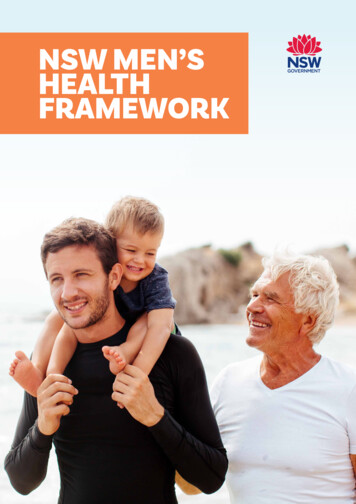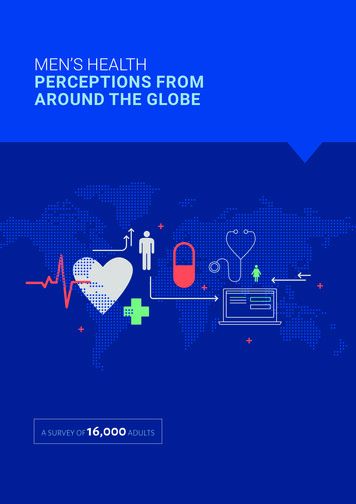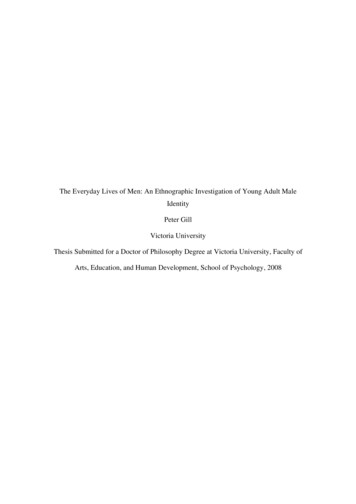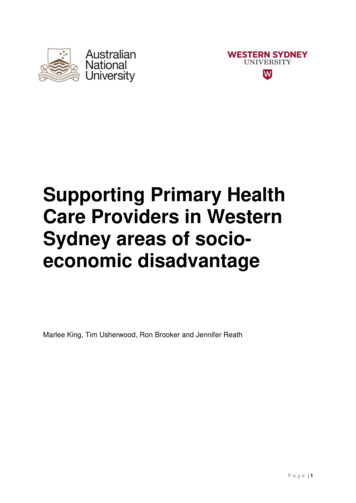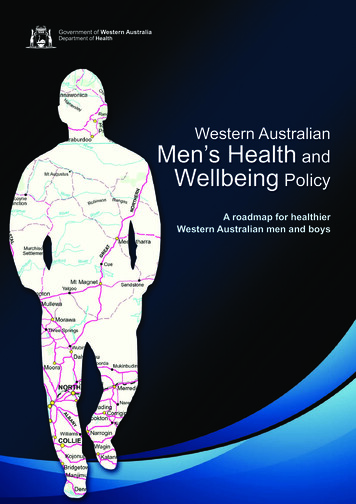
Transcription
Western AustralianMen’s Health andWellbeing PolicyA roadmap for healthierWestern Australian men and boys
Produced by Health Networks WA Department of Health 2019Copyright to this material is vested in the State of Western Australia unless otherwise indicated. Apartfrom any fair dealing for the purposes of private study, research, criticism or review, as permitted underthe provisions of the Copyright Act 1968, no part may be reproduced or re-used for any purposeswhatsoever without written permission of the State of Western Australia.Suggested citationWestern Australian Department of Health. Western Australian Men’s Health and Wellbeing Policy. Perth:Health Networks, Western Australian Department of Health; 2019.Important disclaimerAll information and content in this Material is provided in good faith by the Western AustralianDepartment of Health, and is based on sources believed to be reliable and accurate at the time ofdevelopment. The State of Western Australia, the Western Australian Department of Health and theirrespective officers, employees and agents, do not accept legal liability or responsibility for the Material,or any consequences arising from its use.Contact informationFor further information contact Health Networks, Western Australian Department of Health on(08) 9222 0200 or healthpolicy@health.wa.gov.auAcknowledgement (map cover) 2010 Western Australian Land Information Authority.Base layer reproduced by permission of the Western Australian Land Information Authority.
ContentsAcknowledgementsiiForeword by the Minister for Health1Summary of the Western Australian Men’s Health and Wellbeing Policy2Overview3Health disparities for men4Moving forward with the Policy6Guiding principles6Priority male populations7Policy domains8Areas for action10Using the Policy22Audience22Putting the Policy into practice23Future vision23Monitoring the Policy24Glossary of terms25References27Appendices30Appendix 1: Western Australian Men’s Health and Wellbeing Reference Group30Appendix 2: References for the health disparities for men infographic31Appendix 3: Related policies and frameworks33Men’s Health33Aboriginal Health33Other34Appendix 4: Supporting documents – issues in depth36Western Australian Men’s Health and Wellbeing Policy i
AcknowledgementsThe Western Australian Men’s Health and Wellbeing Policy (the Policy) is the result of extensiveconsultation and considered commentary from a large number of organisations and individuals acrossthe Western Australian (WA) health system and community. We would like to sincerely thank all thosewho contributed, especially the members of the Policy Reference Group (refer to Appendix 1), whoprovided content expertise and insight, community linkages, strategic guidance, and a commitment tooptimise the health and wellbeing outcomes of men in WA.ii Western Australian Men’s Health and Wellbeing Policy
Foreword by the Minister for HealthIt is my great pleasure as Health Minister to be able to introduce the Western Australian Men’s Health andWellbeing Policy, designed to optimise health and wellbeing of all men and boys living in our State.This Policy will provide direction to the WA health system and its partners to deliver strategies to improvethe physical, mental, social and emotional wellbeing of men and boys living in WA.This is a much needed piece of work which outlines clear goals and areas requiring action where menand boys are at higher risk.These are strategies to empower men to be proactive in managing their own health and wellbeing, andhelp to ensure equitable access to important health services which will meet men’s needs.Men continue to face poorer outcomes than women on almost all key health and wellbeing indicators.In WA, males are over-represented in the areas of suicide, cancer, type 2 diabetes, heart and lungdisease and stroke. More than 77 per cent of WA males are overweight or obese, more than 14 per centsmoke and more than 31 per cent exceed alcohol consumption guidelines, which is the highest figure inAustralia. The mental health of our men is also a major concern.Men also have a significantly shorter life expectancy than WA women – at 79.5 years compared with83.2 years. This is lower still for Aboriginal males whose current life expectancy is 65 years.Men in WA are also less likely to use allied health services than are women.These are among the fundamental and compelling reasons to deliver on the McGowan Government’selection commitment to develop this policy and our promise to do more for men’s health.This Policy is the first of its kind in WA and outlines our response to the National Male Health Policy. It isthe result of an intensive phase of research, discussion and consultation with many stakeholders.Community members had the opportunity to provide feedback on the draft Policy, released in June 2018,via either an online survey or at one of the community consultation forums, which included four in themetropolitan region and 15 in regional areas.Between June and August 2018 more than 400 people provided their insights on the draft WesternAustralian Men’s Health and Wellbeing Policy.I would like to thank the many individuals, organisations and service providers who contributed tothe success of the consultation period, by advertising and promoting events to their many networks,attending forums and providing feedback.This process of harnessing the collective wisdom and expertise has been instrumental in thedevelopment of this Policy which will benefit so many.I now look forward to this work being continued and it leading to real gains, tangible actions and healthimprovements for men and boys, and for all those working with them, in communities across our State.Hon Roger Cook,Deputy Premier,Minister for Health; Mental HealthWestern Australian Men’s Health and Wellbeing Policy 1
Summary of the Western AustralianMen’s Health and Wellbeing PolicyOur visionTo optimise the health and wellbeing of all men and boys in WA.Our purposeTo provide direction to the WA health system and its partners to deliver strategies to improve thephysical, mental, social and emotional wellbeing of men and boys living in WA.1.1 Increase efforts towards appropriate health promotionapproaches and activities.1.2 Build understanding of men’s health needs and addressattitudes and culture in order to enable behaviour change.Goal 2Men have equitable accessto services (includingprevention and earlyintervention initiatives)that meet their needs.2.1 Ensure a collaborative, whole of government approachto support a broad, coordinated approach to improvinghealth and wellbeing.2.2 Ensure access to information at appropriate lifeevents/stages.2.3 Adopt a holistic approach to men’s health care andservices that consider social determinants of health.2.4 Encourage early intervention, including opportunisticscreening and treatment.2.5 Improve service delivery and access by ensuring servicesare responsive to men’s health and wellbeing needs.Goal 3Men’s health and wellbeingneeds are monitored,evaluated and inform continualimprovements of programs,services and initiatives.3.1 Collect data to determine and prioritise the diverse healthneeds of men.3.2 Continually monitor and evaluate health initiatives for men.Guiding principles People and community centred Health equity and access Prevention Highest quality HolisticPrority populations Men living with a mental illnessMen living in rural and remote areasMen in low socioeconomic circumstancesMen from culturally and linguisticallydiverse backgroundsPolicy domains2 Western Australian Men’s Health and Wellbeing Policy Collaborative Actions across the continuum Aboriginal men Young men Men with disability Older men Males with diverse sexualities, intersex menand men with transgender experience Men directly impacted by fly-in, fly-out workarrangementsb. Create supportive environmentsa. Build healthy public policy c. Strengthen community actionsPriority areasGoal 1Men are empowered to beproactive in managing theirhealth and wellbeing.d. Develop personal skillse. Reorient health services
OverviewMen are significant and positive contributors to life in WA through their diverse family, work andcommunity roles.1 They need to be empowered to continue this positive involvement, allowed to reachtheir potential and be supported to enjoy a long and high quality life.1However, men continue to face poorer outcomes than women on almost all measures of key health andwellbeing indicators.2 They have lower life expectancy, and have higher levels of mortality from almost allnon-gender specific causes of death including injury, cardiovascular disease, cancer, suicide, respiratorydisease, and obesity.2 In WA, males experience a greater total disease burden than females.3 These healthoutcomes are primarily influenced by:*****level of disadvantagesocial and lifestyle factors such as smoking, excessive alcohol intake, and low fruit andvegetable intakeparticipation in high risk activitiestendency to use health and community services less and at a later stage when encountering ahealth or illness concernpoorer social connections.2The infographic on page four of this document depicts the crisis of men’s health and wellbeing and theneed for more action to be taken to address and prioritise the issue.From a psychosocial, economic and social point of view, improving men’s health and wellbeing is betterfor men, their partners and families, the community and the economy.2 Supporting the health andwellbeing of men needs to be recognised as a whole-of-community issue. This should include a focus onpromoting and facilitating men’s healthy living and strengthening health and community service deliveryto men.2Although the men’s health and wellbeing sector in WA has a perceived lack of clear definition and identity,there is an existing network of services that can be leveraged for improving men’s health and wellbeingoutcomes.1 All services must recognise and address the health and wellbeing needs of men and ensurethey are more strategic, coordinated and gender appropriate.2Western Australian Men’s Health and Wellbeing Policy 3
Health disparities for menSee Appendix 2 for references4 Western Australian Men’s Health and Wellbeing Policy
A timely response – Western Australian Men’s Health and Wellbeing PolicyA policy that can engage and empower men and align the systems, services and communities thatsupport them is urgently needed. The benefits of prioritising and addressing men’s health and wellbeingwill be far reaching not just for men, but also their partners, families, the community and the economy.The development of the Western Australian Men’s Health and Wellbeing Policy (the Policy) is the first steptowards recognising this important issue and calling people to action in WA.For the purpose of this Policy, the term ‘men’ refers to a male of any age, including boys. It isacknowledged that there is diversity in our bodies, sex characteristics, sexualities and gender identities.The Policy was developed by the Health Networks Branch, WA Department of Health to demonstrate theWA health system’s commitment towards achieving the priority areas of the National Male Health Policy:Building on the strengths of Australian males4 and the action areas of the draft National Men’s HealthStrategy 2020-2030.5The purpose of this Policy is to provide direction to the WA health system and its partnersto deliver strategies to improve the physical, mental, social and emotional wellbeing ofmen and boys living in WA.The Policy recognises that the health and wellbeing of men is influenced by the complex and interwovenweb of individual, interpersonal, organisational, social, environmental, political and economic factorsknown as social determinants of health6 (Figure 1). They encourage us to have a deeper understanding ofhealth beyond a focus on biology, physiology and anatomy.Indivemme plont y-Unal lifestyle faidualdan ner ioat itatW ansecaralth sHe ervicesksoracommunity nndetwalrsctoAgricultand fo ureprodu odctiononSociatiLiving and workingconditionsonmentnsi t iouc, cultural and envirndcotEdioork enW nmovirocicomonceenGeneralsFigure 1. Social determinants of health7HousingAge, sex andconstitutionalfactorsMen’s health and wellbeing is the joint responsibility of many agencies and departments beyond the WAhealth system and necessitates a collaborative approach to achieve common goals.The Policy includes three goals, areas for action and advice on how to achieve these goals.The goals and areas for action were developed in consultation with a broad range of stakeholders. Thisconsultation was considered key in ensuring the purpose of the Policy accurately reflected the needs ofmen, and that the actions were tangible for those working with men and their communities throughout WA.The goals are:1.Men are empowered to be proactive in managing their health and wellbeing2.Men have equitable access to services (including prevention and early intervention initiatives)that meet their needs3.Men’s health and wellbeing needs are monitored, evaluated and inform continualimprovement of programs, services and initiatives.Western Australian Men’s Health and Wellbeing Policy 5
Moving forward with the PolicyGuiding principlesThe following guiding principles set the foundation for the intent of the Policy. They exist to ensure thatmen are supported and empowered to strive for and maintain good health.People- and community-centredMen are involved in all decisions regarding their health and wellbeing. They are co-designers in planning,developing and monitoring health services that impact on men, their families and the community.Health equity and accessEquitable access to health services optimises the health and wellbeing of all men.Highest qualityHigh quality policies, programs and services are evidenced-based and seek continual improvementto achieve best-practice. They are co-designed, monitored and evaluated with engaged communitymembers. Opportunities for innovation in program and service design are explored.HolisticThe health and wellbeing of men can be improved by influencing the social determinants of health(see Figure 1).6 Western Australian Men’s Health and Wellbeing Policy
CollaborativeAction to improve men’s health and wellbeing will be best achieved by the collective impact and sharedcommitment of multiple government and non-government organisations, communities and men.Actions across the continuumA flexible approach to programs and services is required to recognise and respond to the unique anddiverse health and wellbeing needs of men (of all ages and at all stages of life) across the continuum,starting with a focus on prevention.PreventionThe development and delivery of preventative health-related initiatives and programs, tailored to the needsof men, is required to keep them healthy and prevent illness.Priority male populationsPriority male populations is the term used within the Policy to highlight vulnerable men who may havecomplex needs and are at higher risk of:*poor health and wellbeing outcomes*barriers to access of health care*health risk behaviours.The Policy also focuses on men, who are not in the priority categories, but have health and wellbeingissues that need to be addressed.It is acknowledged that diversity among men is common and that they have unique and often complexhealth needs. There are differences in health outcomes across the life course and it is important toprovide health services to reach different population groups and men at different stages in their lives.The priority male populations listed in the Policy reflect some of those groups who experienceinequalities in health and wellbeing outcomes including contributing poor health determinants such asmarginalisation, education, poverty and gender.The list is not exhaustive; populations may overlap and encompass varying characteristics andexperiences.These priority male populations have been demonstrated to represent a higher risk of men’s health andwellbeing issues, particularly in relation to chronic conditions, and include:*Aboriginal men*men living with a mental illness*men with disability*men living in rural and remote areas*men in low socioeconomic circumstances*men from Culturally and Linguistically Diverse (CaLD) backgrounds*young men (10-24 years)*older men (65 years and older)*males with diverse sexualities, intersex men and men with transgender experience*men directly impacted by fly-in, fly-out work arrangements.Western Australian Men’s Health and Wellbeing Policy 7
Policy domainsThe Policy outlines three goals, developed in consideration of the National Male Health Policy: Buildingon the strengths of Australian males4 and the draft National Men’s Health Strategy 2020-2030 5 withreference to the specific needs of men in WA.Priority areas for action are identified under each of the goals for more detail and context.The Policy also recognises the following domains as the levers for achieving the goals. For the purposeof this Policy, the Ottawa Charter for Health Promotion8 domains have been used to address the need fora holistic and collaborative approach to the many and complicated issues that affect men’s health andwellbeing. The five domains are:A.Build healthy public policyPolicy development at all levels seeks to promote health and wellbeing. It includes:*legislation*fiscal measures*taxation*organisational change.Health, income and social policies are used to foster equity and ensure:*safer and healthier goods and services*healthier public services*cleaner more enjoyable environments.Policies need to identify obstacles to health and seek to remove them, making the healthierchoice the easiest one.8 Western Australian Men’s Health and Wellbeing Policy
B.Create supportive environmentsThere is a link between people’s health and wellbeing and their environment. Work and leisureenvironments should promote health and wellbeing. Therefore health promotion shouldcreate safe working environments that:C.*are enjoyable*assess health impacts of developing infrastructure (buildings, energy, etc.)*protect natural and built environments.Strengthen community actionsCommunity action is strengthened through communities being involved in setting priorities,making decisions, planning strategies and implementing them to improve health outcomes.The goal is community empowerment, which improves the outcomes of health promotion.D.Develop personal skillsPersonal and social development is supported through information, education and enhancinglife skills. This increases options and control for individuals over their own health. It isessential to equip people for life-long learning and to develop skills for coping with ill health.This is done through school, home, and community settings.E.Reorient health servicesA shift towards a health system which promotes health, rather than curative services isnecessary to focus on the needs of the whole individual, not just their injury, illness or disease.Specific areas for action are mapped under each of the domains and describe what is needed to be done.The areas for action focus on social determinants and an approach which capitalises on the strengths ofmen. It is recognised that there may be additional strategies to address men’s health and wellbeing. Howeverthe following goals, priority areas and actions focus on those that are deemed to have the greatest impacton the specific health needs of men in WA, based on feedback from local consultations and data.1-4, 9-24Western Australian Men’s Health and Wellbeing Policy 9
Areas for actionDomain A: Build healthy public policyNo. Areas for actionA1Promote the importance of addressing men’s health and wellbeingand recognise gender disparities among government agencies andservice providers by:***Create men’s health and wellbeing policies and policyimplementation plans that:*10 444seeking acknowledgement of the need to contributefunding and resources towards men’s health and wellbeingin WA, especially where disparities exist.A3*4Goal 3ensuring any initiatives stemming from this Policy alignwith existing structures, strategies, plans and coordinationmechanisms at both a state and national level to avoidduplication or siloed approaches e.g. Sustainable HealthReviewEnsure policy planners involve men in design, development andevaluation of policy to ensure men’s needs remain core to the policyprocess.*Goal 2advocating for this Policy to be used as the foundation fordevelopment of policies impacting on men’s health andwellbeing across government (e.g. prison health)A2*Goal 1are flexible enough to adapt to emerging health andpopulation trendsconsider the impact on men’s health and possible impactson priority male populations in WAfocus actions on trying to promote change to fundamentalsocial determinants of healthprioritise service provision and funding towards prioritymale populations, where appropriate in WA.Western Australian Men’s Health and Wellbeing Policy44
Domain A: Build healthy public policyNo. Areas for actionA4Develop standards and frameworks for commissioning/procurement of men’s health and wellbeing programs, services andcampaigns that:*****444are holistic, culturally appropriate, and designed for menwith men’s involvement at all levels and agesaddress common unhelpful stereotypesadopt strength-based approaches e.g. reinforcing theimportance of men in the community and that taking careof personal health is a sign of strength and enables mento maintain their roles as wage earners, partners, carers,family members and friends.A6Strengthen the evidence base that helps us to understand the waymen think and respond to their health and wellbeing, and theirbarriers for accessing support or services. This can be achievedthrough:A74Goal 3are evidence-based or evidence-informed and evaluated,while allowing opportunity for innovationLook for opportunities to integrate the Western Australian Men’sHealth and Wellbeing Policy into local planning and environmentsin which men live and work and identify opportunities in localgovernment for health and wellbeing plans.*Goal 2foster empowerment and self-managementA5*Goal 14reviewing international research on barriers and enablersof men’s uptake of health services over the generationspromoting the need for better testing of education andtreatment messages nuanced for men.Give attention to research in men’s health especially in areas that:*consider the interaction of the social determinants ofhealth on sex, age and different population groups ofmales, including those from gay, bisexual and transgendergroups and culturally diverse population groups*focus on men living in rural or remote areas*focus on men with disability**4focus on Aboriginal men’s health in partnershiparrangements with Aboriginal menidentify strategies to build resilience in adolescents andadult men to enable them to deal effectively with adverselife events such as divorce and re-parenting.4Western Australian Men’s Health and Wellbeing Policy 11
Domain A: Build healthy public policyNo. Areas for actionGoal 1Goal 2Goal 3A8Explore the potential for surveys such as the WA Health andWellbeing Surveillance System Survey to establish baselines of healthand wellbeing and use the data to re-shape health service delivery.44A9Build routine evaluation of health outcomes into health programsand services and ensure results are disseminated as widely aspossible, including to men and in formats that are accessible andunderstandable to individuals, for example4:44**12 establish a framework and tools to measure the quality andperformance of health promotion initiativescreate a set of standard minimum demographicinformation to collect from participants in local programs(i.e. sex, age, geographic location, ethnicity and othervariables that are relevant to measuring health outcomesfor particular population groups of males)Western Australian Men’s Health and Wellbeing Policy
Domain B: Create supportive environmentsNo. Areas for actionB1Seek opportunities to bring together quality services and initiativeswhich recognise and cater to diversity, to be accessible by menand their families in their communities and work environments. Forexample:*aGoal 1Goal 2Goal 34collaborate with key health organisations such as the RoyalAustralian College of General Practitioners (RACGP),beyondblue or Primary Health Networks to deliverevidence-based health checks, screening for stress andmental health issues and health promotion programs toemployees.4B2Explore opportunities for the establishment of an online resourcecentre to be a central repository for resources, services and advicefor the community on men’s health and wellbeing.44B3Encourage service providers, workplace and communityorganisations to develop supportive spaces and culturea for men tohave discussion and seek support on health and wellbeing issues,e.g. relevant literature in waiting rooms, screen tools and literatureor e-health kiosks.44B4Develop strategies to connect men with local services that supporttheir health and wellbeing. This would enable the linkage of men toquality evidence-based services via a number of mediums (online,telephone, social media and face-to-face) to enable accessibility.244culture refers to values, traditions, beliefs, interactions, behaviours and attitudes.Western Australian Men’s Health and Wellbeing Policy 13
Domain C: Strengthen community actionsNo. Areas for actionC1Identify a peak body for men’s health and wellbeing to coordinate,promote, support, and represent the needs and activity of healthservice providers within the WA health sector.2C2Consider the development of a men’s health action group thatbrings together stakeholders from across community, government,non-government and industry sectors to:******Goal 14444generate conversations and activities that keep men’shealth and wellbeing front of mind and advocate forsupport on action on areas of the Western AustralianMen’s Health and Wellbeing Policyprovide an opportunity for inter sectoral partnerships andcollaboration for common projects and goalsshare new and existing data and research into men’s healthand wellbeingshare information on current initiatives in men’s healthand wellbeing to avoid duplication and combine resourceswhere appropriatepromote and facilitate the implementation of the WesternAustralian Men’s Health and Wellbeing Policyadopt a collaborative approach to seeking funding andinvestment opportunities for the development and deliveryof new health and wellbeing-related research, initiativesand services.C3Identify men’s health advocates within organisations and servicesthat impact on men’s health and wellbeing.4C4Create a network of local champions/community advocates/ambassadors to promote key messages and address negativestereotypes (e.g. collaboration with local YouTube stars or onlinegaming community).4C5Acknowledge, respect and celebrate, at all levels of society, thepositive roles of all men regarding cultural practices, obligations,parenting and spirituality, and interconnectedness betweenindividuals, families and communities.414 Goal 2Western Australian Men’s Health and Wellbeing PolicyGoal 3
Domain C: Strengthen community actionsNo. Areas for actionC6Acknowledge, respect and celebrate, at all levels of society, thevaluable roles men play in family and community life.4 This could bedone through:****C7Goal 1Goal 2Goal 34all health practices providing family-friendly services thatare openly inclusive of fathers/grandfather/carerschildcare providers and family community services activelyencouraging the involvement of fathers/grandfather/carersmedia promoting men as positive family members androutinely presenting images of males with children whenreporting on familiespromoting positive messages to address genderstereotyping regarding the involvement of men in familyand in the community (e.g. primary and secondary schoolspromoting positive roles of men).Support sons, husbands, fathers, brothers to take early stepstowards prevention of risky behaviours and accessing assistancefor their health and wellbeing.4Western Australian Men’s Health and Wellbeing Policy 15
Domain D: Develop personal skillsNo. Areas for actionGoal 1D1Provide comprehensive, evidence-based health promotionstrategies, programs and interventions that target education, skillbuilding, behaviour change and attitude change to empower andenable men as part of the community to take charge of their healthand act to create positive and lasting change.4D2Address attitudes and social stigmas by:4******16 acknowledging an individual’s motivation to seek, andaccept information or advicetapping into men’s self-reliance, independence andresilience to encourage them to be more active in seekingprofessional health advicemaking it socially acceptable to have regard for yourhealth, and to get help or ask for helpaddressing the ‘she’ll be right’ attitude and associatedstereotypical attitudespromoting that improving the health and wellbeing of menpositively impacts the health and wellbeing of women,children, families, the economy, the workforce and thebroader community1talking about the positive sides of being a man, in theparadigm of masculinity, i.e. the man that takes everythingin life as a challenge and meets life head-on; the man thatis grounded in himself that has an understanding of hisown social/spiritual wellbeing; the man that has qualitiesof good character.Western Australian Men’s Health and Wellbeing PolicyGoal 24Goal 3
Domain D: Develop personal skillsNo. Areas for actionD3Support behaviour change (including increasing knowledge andskills of preventative and protective health behaviours) in thefollowing ways:******D4*Goal 244Goal 3grow men’s capacity for meaningful connection (firstwith other men, then with support services) and theunderstanding that they have both a ‘right’ and a‘
2.3 Adopt a holistic approach to men's health care and services that consider social determinants of health. 2.4 Encourage early intervention, including opportunistic screening and treatment. 2.5 Improve service delivery and access by ensuring services are responsive to men's health and wellbeing needs. Goal 3 Men's health and wellbeing

